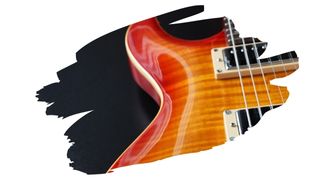There are only really a handful of wood types that work well as unfinished fretboard material.
Why? Well, because fretboards are cut pretty thinly, so they need to be made from wood that’s fairly dense and hard.
On top of that, if wood is to be left unfinished, it needs to be naturally durable and warp-resistant. Especially as, (without a sealing finish to protect it), an unfinished fretboard can become susceptible to cracking and splitting.
So, the bar has been set pretty high by woods such as Rosewood and Ebony wood. These two tropical hardwoods have all the natural characteristics needed to make for long-lived (and low-maintenance) guitar fretboards.
But what about Roasted Maple?
This specially-treated hardwood looks and feels great to play, but does a Roasted Maple neck need a sealing finish? Or can it do just as well without any finish at all?
Well, in this post, you’ll learn the difference between unfinished and finished fretboards — and why it matters if you want to prevent a fretboard from cracking. You’ll also find out what makes Roasted Maple uniquely different from regular Maple timber.
And keep reading to find out why — depending on your local climate — Roasted Maple guitars may very well need a finish after all.

This post may contain affiliate links to products that we receive a commission for (at no additional cost to you). Learn more here.
What Are Unfinished Fretboards Exactly?
Unfinished fretboards do not have a protective top coat finish added to them to safeguard them.
But typically, Maple guitars are almost always finished, since this particular hardwood isn’t very stable.
A finishing coat will prevent Maple wood from drying out. And, if Maple doesn’t have a finish, it can ultimately lead to cracks and splits.
Related Post: Are Glossy Maple Guitar Fretboards Any Good?
So How Are Roasted Maple Necks Any Different From Regular Maple Ones?
Roasted Maple is actually made from regular Maple wood.
But, having been put through a super-heated caramelizing treatment, Roasted Maple timber is more stable than untreated Maple wood.
And why is that? Well, its because Roasted Maple wood has very little moisture in it (compared to untreated Maple). And the reduced moisture content in Roasted Maple means it’s less likely to shrink and crack.
This is the main reason why Roasted Maple guitar necks are left unfinished, while untreated Hard Maple necks need a protective finish.
So You Don’t Really Need To Finish Roasted Maple?
In theory, no you don’t.
You see, the main reason why we finish a fretboard is to prevent it from drying out and cracking. And a water-repellent finish, such as Tung oil or Lacquer, will prevent that thin fretboard wood from splitting.
However, because Roasted Maple wood is already so dry, there’s little moisture left in it to dry out even more. And because of that, this heat-treated Maple wood is less likely to shrink and crack.
Great! So That’s All Figured Out Then…
Not quite.
You see, there’s a little bit of an issue with leaving Roasted Maple guitar necks unfinished. So much so, that guitar makers are starting to change their thinking on whether Roasted Maple should be left unsealed.
Why? Well, because in practice, Roasted Maple may likely need a finish anyway.
Wait A Second…Why Do Roasted Maple Necks Need A Finish Again?
First off, just to be clear, if you store your guitar carefully, then that Roasted Maple fretboard should be fine.
However, if you live in a fairly humid climate, then you may start to come across a few problems. And those problems will arise regardless of how careful you are about storing your instrument.
Now the problem is pretty simple; Roasted Maple isn’t made from a naturally stable or warp-resistant wood type. So, just like regular untreated Maple, it is not moisture-resistant.
So, Roasted Maple fretboards will absorb moisture from the air (i.e. humidity). And later on, as it dries back out, you will begin to see those annoying fine cracks start to appear on this timber.
Now, compare this to say Rosewood fretboards.
Rosewood is a tropical hardwood that contains natural tree oils that make this a very oily wood. And the oils inside Rosewood stop this hardwood from drying out. However, on top of that, those same oils also prevent Rosewoods wood fibers from wicking up moisture as well.
Related Post: What Can You Use As A Rosewood Fretboard Finish? (Revealed!)
This is why Rosewood can be left unsealed — and rarely needs fretboard oil conditioning afterward.
But — roasted or not — Maple wood has nothing about it to naturally stop it from absorbing moisture in this way. So without a sealant, Roasted Maple can warp (eventually cracking) in climates that have regular high-humidity/heat weather cycles.
In fact, Roasted Maples inability to handle humidity (and general lack of rot-resistance) is why it is not suited for exterior wooden structures.
Related Post: Is Maple Wood A Good Choice For Outdoor Furniture?
So Should Roasted Maple Necks Always Be Finished?
If you live in a rainy — or an otherwise humid hot climate — then you should seal that guitar neck. In fact, you won’t go too far wrong by applying a very thin finish to it, such as Tru Oil.
Related Post: Tru-oil Vs Tung Oil: Which One’s Better For Your Guitar?
However, if you live in a very dry climate — and you carefully store your guitar — you won’t need to finish that Roasted Maple neck.
To Wrap Up, Here Are The 3 Key Takeaways From This Post…
- 1). Roasted Maple is made by heat-treating regular Maple wood. This treatment caramelizes Maple wood and makes it more stable and more warp-resistant.
- 2). Roasted Maple wood contains less moisture than regular Maple wood. As a result, it is less likely to shrink and crack due to the moisture content of this wood evaporating.
- 3). Roasted Maple is not naturally rot-resistant. And, unlike say Rosewood, it has no natural safeguards to protect it from absorbing moisture. So if you live in a more humid climate, you should apply a finish to Roasted Maple to protect it from cracking.



